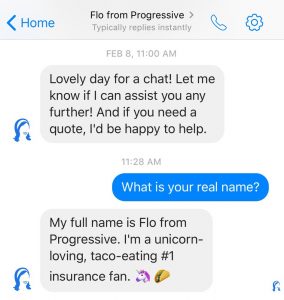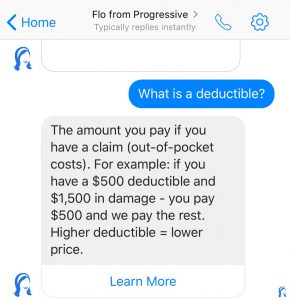Guess who wants to talk! How Flo and her fellow chatbots engage customers
Exuding her famous friendly Flo-ness, she greets you with a wink in her words and a plan for your auto coverage.
“Welcome friend! You’re looking positively radiant today,” she says, before sharing a photo of her true love:

She’s always ready to riff on fun topics (“unicorns”) or her dinner plans (“a taco”) or even her own vehicle (“I drive a car that runs on smiles”). Then she’s all business: “Now, back to your quote.”
You know her as Flo, the white-clad, swoop-haired, sun-shiny character from TV ads promoting Progressive Insurance.
These days, Flo also works a side job, joining a rising crew of commercial chatbots equipped with artificial intelligence to mimic human conversations, grasp consumer questions and take swift action.
This new wave of virtual agents – also spanning chatbots launched by UPS and Sabre – engages customers in online places they may roam, from Facebook Messenger to Skype. They’re made to tackle routine tasks, such as creating insurance quotes, tracking packages or changing airline flights.
But with AI informing the chatbots’ interactions, the bigger idea is to provide something with more emotional intelligence than a digital tool.
 “Probably our biggest core principle in building this: Try not to sound like a robot,” says Matt White, a marketing process manager with Progressive. The company’s headquarters is located near Cleveland, Ohio.
“Probably our biggest core principle in building this: Try not to sound like a robot,” says Matt White, a marketing process manager with Progressive. The company’s headquarters is located near Cleveland, Ohio.
“We want to use simple, natural language. We want to add some personality and inject some wit where appropriate,” White says of his company’s Flo chatbot, launched in October. “I guess the best way I can describe it is: We are looking for opportunities to delight.”
The digital version of Flo helps customers move payment dates, file accident claims, get auto quotes and more. She also can answer Insurance 101 questions like: What’s liability?
The TV persona already has her own Facebook page (with more than 4 million followers), where users can query Flo through Facebook Messenger. According to Progressive, several thousand users have communicated with the chatbot, typing more than 15,000 individual questions, or “utterances” in tech vernacular.
Two more key pieces of chatbot vocab include “intents,” the meaning behind users’ questions, and “entities,” the sentences within a chat.
To make it all work, Flo met LUIS.
 Technically speaking, Progressive’s chatbot uses Language Understanding service, part of Microsoft Cognitive Services, and LUIS for short.
Technically speaking, Progressive’s chatbot uses Language Understanding service, part of Microsoft Cognitive Services, and LUIS for short.
Designed to identify crucial information in conversations, LUIS interprets user intents and distills valuable details from entities. The result: a bot that can process, understand and speak with natural language.
And as a machine learning-based service, LUIS constantly improves a bot’s communication game. That means Flo learns from each customer encounter.
She also admits when a customer’s words aren’t clicking for her. In those cases, she may respond: “I’m not picking up what you’re putting down. Try another way of asking me.” If the follow-up question doesn’t make sense to her AI brain, she may reply: “I’m sorry this isn’t working out as planned. Would you like to speak with someone directly?”
At that point, a customer can ask Flo to connect them with a live Progressive expert.
The ability to transfer from a virtual agent to a human also underpins an AI chatbot launched in February by Sabre, a technology solutions provider to the global travel industry
Sabre is piloting its chatbot with Travel Solutions International USA (TSI), a travel agency. TSI, which nicknamed the bot “Ella,” makes it available via the TSI app or through the company’s Facebook page. Users can change existing flights, request special meals, select and pay for seats, obtain emailed itineraries, and ask trip-related questions about a gate number, flight status and more.
During the pilot phase, Sabre and TSI are measuring how often and when travelers engage with Ella and when they are likely to divert to an agent.
“TSI is interested in identifying ways to direct more of the routine requests to a technology solution such as the bot, thereby enabling their agents to focus on more complex and revenue-generating conversations with passengers – moments when you actually want that person-to-person interaction,” says Chad Callaghan, director of Sabre Studios, an innovation lab within Sabre. The company is based near Dallas, Texas.
“Think: the multi-leg, complicated, international itinerary. You want that human interaction. So how can technology help augment the productivity of their agents?” Callaghan adds.
To build its chatbot, Sabre utilized the Azure Bot Service and a selection of Microsoft Cognitive Services, including LUIS.
The company leaned on those services, in large part, because it recognized the deep challenge of applying language-understanding tools to the unique lingo and location names that are core to the travel business, Callaghan says.
“To understand the Bot Service, think about going into the tools section at Home Depot where you can pick up saws or hammers in all different colors and different brands. For the bot market, Microsoft has created that kind of toolkit, filled with the digital screwdrivers, hammers and wrenches you need to help you get started building a bot,” Callaghan says.
![]() The Azure Bot Service also served as the foundation for a UPS chatbot – launched in November 2016 – that enables customers to research shipping rates, track packages and find UPS locations. The bot runs on Microsoft Azure. Users access it via Facebook Messenger, Skype and Amazon platforms.
The Azure Bot Service also served as the foundation for a UPS chatbot – launched in November 2016 – that enables customers to research shipping rates, track packages and find UPS locations. The bot runs on Microsoft Azure. Users access it via Facebook Messenger, Skype and Amazon platforms.
“The chatbot … provides a more natural, intuitive, personalized and human-like interaction between UPS and its customers,” says Kumar Athreya, a UPS senior manager for applications development.
UPS, headquartered in Atlanta, plans to give users the ability to opt out of a bot chat so they can speak with a live agent, if desired.
“With these tools and technologies, we are closer to the beginning than the end of the journey,” says White, of Progressive. The insurance company also uses Microsoft Bot Service as well as Cognitive Services’ QnA Maker, which enables a bot to answer frequently asked customer questions.
“The ceiling is pretty high as to where we think we can go, serving our customers’ needs with fast responses and by being convenient for them,” White says. “But certainly, there are areas where a human touch is required and, frankly, preferable.”
Even if a chatbot like Flo sometimes seems utterly human.
Such as during this actual conversation:
FLO: I love to help! You can ask me anything from how to update your policy to general insurance-y questions. e.g. What is liability? Or we could just chit chat about our hopes and dreams. It’s up to you!
CUSTOMER: What are your dreams, Flo?
FLO: Mostly, I dream of helping you save on car insurance
CUSTOMER: Cool. Gotta run but I’ll get back to you later for a quote.
FLO: Goodbye then!
Top image: Flo, the TV commercial character for Progressive Insurance. Image courtesy of Progressive. Screenshots of Progressive chatbot courtesy of Progressive. Screenshot of UPS chatbot courtesy of UPS.








